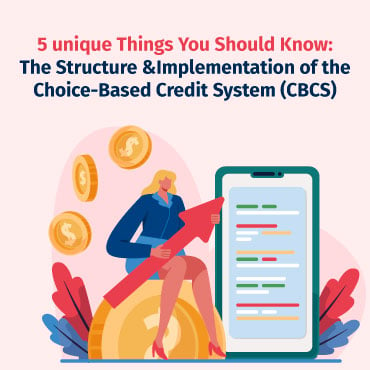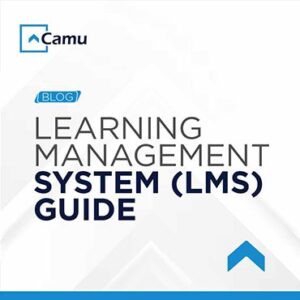
5 unique Things You Should Know: The Structure & Implementation of the Choice-Based Credit System (CBCS)
Good education is crucial for improving knowledge, fostering skills, boosting self-assurance, and improving students’ lives. It gives them the tools they need to advance not only personally but also professionally. Higher education institutions must concentrate on striking a balance between educating students and encouraging skill development by giving them the freedom to explore other subjects to guarantee the quality of their education. Since technology is always evolving and automation is increasing at a rapid rate, students must be better prepared for the workplace. The growth of students can be complemented and energised by studying and comprehending other departmental courses. For example, a student who has a major in science can also learn accounting which would be helpful while working.
What is a choice-based credit system(CBCS)?
The university grants commission made some significant changes to the traditional teaching-learning system by introducing the “Choice Based Credit System,” also known as CBCS, which offers a convenient at the same time effective teaching-learning platform wherein the student has the flexibility to choose their course from a list of electives and core courses. These changes were made to maximise skill-based education and enhance student learning outcomes in terms of their grades as well as skills.
Students can choose courses from the mandated courses, which include core, elective, minor, or skill-based courses, through the CBCS (Choice-Based Credit System). Grading systems are frequently used to evaluate the courses; these systems are seen to be superior to conventional marking systems. The traditional higher education system didn’t provide students with a lot of options. The instructional materials for the course were outdated, redundant, and preset. The traditional segregated courses lacked current applicability, making it difficult for students to utilise their knowledge base later in their job environment, business, or life.
Structure and implementation of Choice-based credit system(CBCS)
The Choice-Based Credit System, which was introduced by the University Grants Commission (UGC), has generated a lot of discussions (CBCS). To support the Ministry of Human Resource Development (MHRD), the Government of India, in achieving the objectives of the New Education Policy (NEP), UGC seeks to establish a “learner-centric” approach throughout the whole education delivery system.
You should be aware of the following 5 information regarding the design and implementation of the choice-based credit system (CBCS)
1. Learner-Centric Approach
The “Student-Centric” nature of the learning system is the most significant shift brought about by the CBCS system. According to their learning goals, interests, and ability, CBCS students can select inter-disciplinary, and intra-disciplinary courses, skill-oriented papers (even from other disciplines), and other learning options. Students will be able to earn credits by fusing unusual topic areas, like chemistry and accounting or biology and statics, for example. To complete a course, CBCS allows students the option to study at various times and various locations, facilitating their mobility. With the aid of academic back of credits(ABC), it is also feasible to transfer credits earned from one institution to another. ABC is a virtual/digital repository that houses data on the credits obtained by certain students over the course of their academic careers. Students will be able to create an account and have a variety of alternatives for enrolling and exiting colleges or universities.As a result, the CBCS system offers significant flexibility to fulfil the needs of every student when properly applied.
2. Subject Categories
The CBCS system gives students the option of three different course types: Core, Elective, and Foundation.
A. Core Course: To fulfil the credit requirement, students are required to enrol in a core course.
B. Elective Courses: These classes are meant to improve students’ skills and have more general topics. They introduce the learner to topics outside of their course of study. Students are given the flexibility to choose the subjects that most interest them.
C. Foundation: The foundation courses, which are also known as “ability enhancement courses,” offer value-based subjects that advance understanding. Such morally upright studies can ultimately open up fantastic employment chances for students.
Core, optional, and foundation courses are each given a different number of credits. By strengthening their talents, students are encouraged to be all-rounders, which is the main goal of this thoughtful CBCS programme.
3. Grading
In the CBCS system, an academic year is made up of two consecutive semesters (odd and even). After each semester, students’ performance in each subject is graded and evaluated. Credit-based grading is used in CBCS. The assessment and examination management practices used in CBCS go beyond the traditional percentage and grading methods of assessing a student’s academic abilities. The grading scheme used by the CBCS system is the same in all educational institutions. Thus, the credit method of grading is more efficient than the traditional percentage system. A 10-point grading scale, with 0 representing absence/failure and 10 representing excellence, has been implemented by the University Grants Commission.
4. Ballot system
The easiest way to implement the CBCS system at a school for a small cohort of pupils is through the ballot method. Every semester, all of the courses that are offered to students are made available as empty bins (subject to UGC standards and instructor availability). Then, after placing a paper with their name on it in the bag designated for that topic, students can select the subject of their choosing. This will enable the institution to compile data on the courses that students select. After selecting all of the subjects, the topic-specific instructor digitises the student list for each subject and provides the students with all of the subject-specific information (timetables, syllabi, etc.). To perform tasks like attendance monitoring and grading, among others, the integration of the student information system (SIS) and learning management system (LMS) with CBCS might be used.
5. Online System
An automated online system created to your specifications would be a superior option to manual labour when a large group of pupils has to use the CBCS system. The effective and simple adoption of the CBCS system on your campus should be ensured by an online system like a student information system (SIS) and learning management system (LMS) integrated with CBCS. This system will also enable you to develop, customise, and make modifications in the future. You should be able to create timetables, track attendance, assign grades, and more with the aid of an effective online system while implementing CBCS on your campus.
How does the CBCS System Operate?
With the choice-based credit system, students select their courses from among the required ones. The courses can be finished at the students’ speed and are referred to as core, optional, major, or minor courses. These courses are evaluated using a credit system. It enables students to select courses from any institution or university worldwide.
1. Semesters
Depending on the course they are enrolled in, students are evaluated at the end of each semester. Instead of finishing the course within the allotted amount of time, they proceed at their leisure.
2. Payment System
There are a certain number of credits assigned to each course. After completing the course exam, students are awarded the credits.
3. Credits Carryover
If the student doesn’t finish the course, the credits may be carried over to the following semester or the one after that.
4. Complete Continual Evaluation
Both the professors and the students themselves continuously assess the pupils’ development.
5. Grading:
A 10-point scale has been established by the University Grant Commission to evaluate student performance.
How can Camu help in implementing CBCS?
To implement the Choice Based Credit System (CBCS system), educators must get in touch with an educational ERP provider like CAMU that provides reliable software that could comply with the CBCS pattern’s rules. It must have functions that let them specify prerequisites, such as defining courses, assigning lecturers, specifying credit requirements, offering courses, allocating courses to multiple teachers, generating dynamic timetables, lesson planning, learning and assessments, and mapping learning contents with course outcomes. Camu has several exciting features and functions that simplify the use of CBCS. A student’s lifecycle from admission to graduation is managed, for instance, through the Student Information System with Choice-Based Credit System. Seamlessly maintaining student information, registrations and grading are crucial duties for colleges.
Camu has become a popular option for educational institutions all around the world. We help colleges achieve their academic objectives by fully using technology. The cloud-based platform is strengthened by cutting-edge technology and effectively supports new learning paradigms. Additionally, it enables administrative and academic procedures at educational institutions to be streamlined. This is crucial in helping students stay focused on their career objectives. Camu is made to facilitate learning while travelling. Camu may simplify academic and non-academic services on a cloud-based platform that is simple to use and can be scaled to your needs, regardless of how big or small your institution is.







